Cell Culture Hydrogel Market Research, 2035
The global cell culture hydrogel market size was valued at $400 million in 2023, and is projected to reach $2,136.7 million by 2035, growing at a CAGR of 15% from 2024 to 2035. The cell culture hydrogel market is driven by the growing demand for advanced 3D cell culture systems in biomedical research, regenerative medicine, and drug development. In addition, the increase in funding for cell-based research, rise in focus on personalized medicine, surge in prevalence of chronic diseases such as cancer, and advancements in hydrogel technologies for improved cell growth and differentiation further propel the market growth. For instance, American Cancer Society, around 2 million new cancer cases were estimated to occur in the U.S. in 2024.
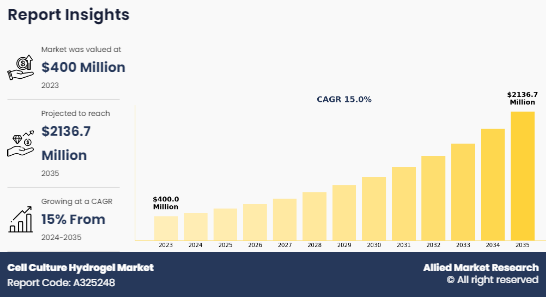
Cell culture hydrogels are three-dimensional, cross-linked polymer networks that provide a scaffold for cell growth and tissue development in vitro. These hydrogels closely mimic the natural extracellular matrix (ECM), offering a hydrated environment that supports cellular functions such as adhesion, proliferation, and differentiation. By facilitating 3D cell culture, hydrogels enable the formation of tissue-like structures, enhancing the physiological relevance of laboratory models used in biomedical research, drug development, and regenerative medicine.
Key Takeaways
- By type of hydrogel, the synthetic hydrogels segment was the largest contributor to the market in 2023 and is expected to register the highest CAGR during the forecast period.
- By application, the tissue engineering and regenerative medicine segment dominated the market share in 2023. However, the cancer and stem cell research segment is expected to register the highest CAGR during the forecast period.
- By end user, the pharmaceuticals and biotechnology companies segment was the largest contributor to the market in 2023. However, the CROs segment is expected to register the highest CAGR during the forecast period.
- By region, North America was the highest contributor to the market in 2023. However, Asia-Pacific is expected to register the highest CAGR during the forecast period.
Market Dynamics
According to cell culture hydrogel market opportunity analysis, the cell culture hydrogel market is driven by a combination of technological advancements, increase in R&D activities, and surge in demand for 3D cell culture systems in various biomedical applications. Hydrogels, with their ability to closely mimic the extracellular matrix (ECM), are becoming increasingly essential in advancing cellular biology, tissue engineering, and drug discovery research. These hydrogels provide a scaffold that supports cell proliferation, differentiation, and migration, offering a more physiologically relevant model compared to traditional 2D culture methods. This led to their widespread adoption in academic, industrial, and clinical research settings.
One of the key drivers of the market is the rise in prevalence of chronic diseases and the need for innovative treatment strategies. Conditions such as cancer, cardiovascular diseases, and neurodegenerative disorders require advanced therapeutic approaches, and cell culture hydrogels are pivotal in enabling researchers to study disease mechanisms and test potential treatments in a controlled environment. Hydrogels have shown significant promise in creating tumor-like microenvironments for cancer research, allowing scientists to better understand tumor progression and drug resistance, which is critical for developing effective therapies.
Furthermore, in drug discovery and development, pharmaceutical companies are increasingly utilizing cell culture hydrogels to create accurate disease models for high-throughput screening of drug candidates. The ability of hydrogels to replicate in vivo-like conditions helps reduce the reliance on animal models, accelerating the drug development process and ensuring better prediction of clinical outcomes. The shift towards 3D cell culture methods is supported by regulatory bodies, which are encouraging alternatives to animal testing to improve ethical standards and efficiency in preclinical research.
Technological advancements are another major driver of the groth of cell culture hydrogel market size. Innovations in hydrogel formulations, such as bioactive and stimuli-responsive hydrogels, are enhancing their functionality and expanding their applications. Companies are developing hydrogels with tunable stiffness, degradability, and biochemical cues to meet the specific requirements of diverse research applications. These advancements are enabling the creation of complex tissue models, such as those for liver, heart, and neural tissues, further boosting the cell culture hydrogel market growth.
Moreover, the increasing focus on personalized medicine is driving demand for advanced cell culture systems. Hydrogels allow researchers to recreate patient-specific disease models, aiding in the development of tailored therapies. This trend is particularly prominent in oncology, where personalized drug screening and therapy optimization are gaining traction. Supportive government policies and funding initiatives are also playing a crucial role in driving the cell culture hydrogel market. Many countries are investing in biotech research and infrastructure to foster innovation in life sciences. Collaborative efforts between academic institutions, research organizations, and industry players are creating a favorable environment for cell culture hydrogel market growth
However, the complexity of hydrogel formulations and the need for specific conditions for their successful application in cell culture pose difficulties in scaling up production thereby limiting the market growth. Regulatory hurdles, particularly related to the use of certain materials in biotechnological and pharmaceutical applications, also slow market expansion. In addition, the lack of standardized protocols for the use of cell culture hydrogels further limits their widespread adoption. On the other hand, advancements in biotechnology and regenerative medicine provides an opportunity for the market growth. Increasing research in stem cell therapy, tissue engineering, and personalized medicine fuels demand for hydrogels as effective scaffolding materials. These hydrogels offer a conducive environment for mimicking the extracellular matrix, enhancing cell growth and differentiation, which is crucial for developing novel therapies.
Segmental Overview
The cell culture hydrogel industry is segmented on the basis of type of hydrogel, application, end user, and region. By type of hydrogel, the market is classified into natural hydrogel, synthetic hydrogel and hybrid hydrogel. By application, it is segregated into cancer and stem cell research, tissue engineering and regenerative medicine, drug discovery and toxicology testing, and other. By end user, the market is divided into pharmaceutical and biotechnology companies, CROs, research institution, and others. Region-wise, the market is analyzed across North America, Europe, Asia-Pacific, and LAMEA.
By Type of Hydrogel
The synthetic hydrogels segment held the largest cell culture hydrogel market share in 2023 and is expected to register the highest CAGR during the forecast period. This is attributed to their consistent quality, tunable mechanical properties, and enhanced biocompatibility. These characteristics make synthetic hydrogels ideal for various applications, including tissue engineering, regenerative medicine, and drug discovery, where precise control over the cellular environment is critical.
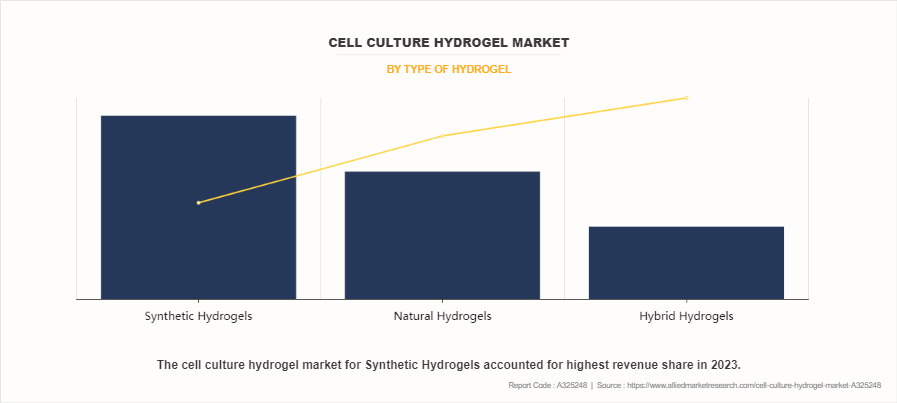
By Application
The tissue engineering and regenerative medicine segment held the largest cell culture hydrogel market share in 2023. This is attributed to the growing demand for innovative scaffolds and biomaterials for tissue repair and regeneration. Cell culture hydrogels mimic the natural extracellular matrix, making them ideal for engineering tissues and supporting advancements in regenerative medicine applications, such as organ repair and wound healing. However, according to cell culture hydrogel market forecast analysis the cancer & stem cell research segment is expected to register the highest CAGR during the forecast period. This is attributed to the increase in focus on understanding cancer biology and advancing stem cell therapies. Cell culture hydrogels provide a 3D environment that mimics tumor microenvironments and supports stem cell proliferation, enabling more accurate research models and innovative therapeutic developments.
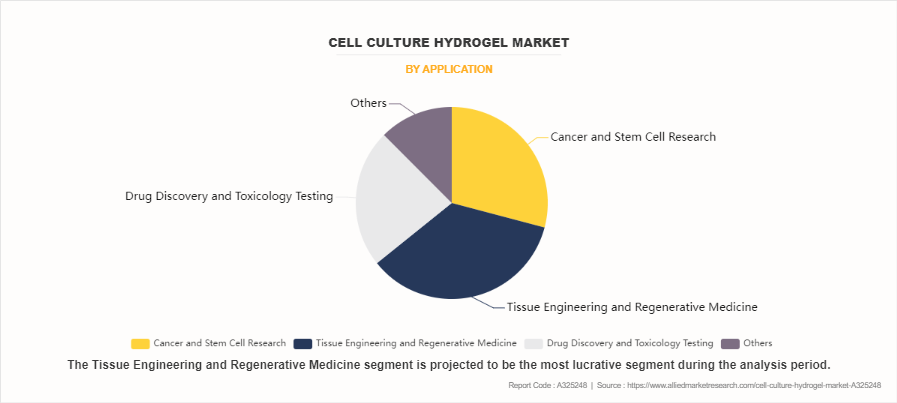
By End User
The pharmaceutical and biotechnology companies segment held the largest share of the cell culture hydrogel market in 2023. This was attributed to their extensive use of hydrogels in drug discovery, development, and screening processes. The ability of hydrogels to mimic physiological conditions supports advanced research, enabling the development of effective therapeutics and reducing reliance on animal models, which accelerates drug development timelines.
However, the CROs segment is expected to register the highest CAGR during the forecast period. This is attributed to an increase in outsourcing of research activities by pharmaceutical and biotechnology companies. The adoption of cell culture hydrogels by CROs enables efficient preclinical studies, offering cost-effective solutions and expertise in advanced research methodologies, thereby driving their segment growth.
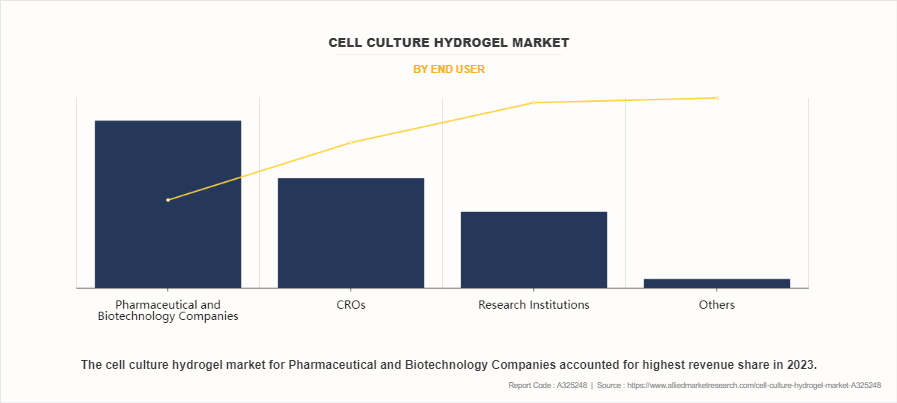
By Region
North America dominated the cell culture hydrogel market in 2023, primarily due to the strong presence of leading biotechnology and pharmaceutical companies. The increasing adoption of cell-based therapies and the rising demand for advanced research tools in drug development have significantly contributed to market growth in the region. In addition, substantial investments in healthcare infrastructure, coupled with the growing focus on regenerative medicine and tissue engineering, have further driven the demand for cell culture hydrogels.
However, Asia-Pacific is expected to register the highest CAGR during the forecast period, driven by rapid advancements in biotechnology and healthcare sectors across key countries. Increasing investments in research and development, along with a growing focus on personalized medicine, are fueling demand for cell culture hydrogels. The rising prevalence of chronic diseases, such as cancer, is also contributing to the adoption of advanced cell culture technologies. Furthermore, improving healthcare infrastructure, increasing government support, and the expansion of healthcare initiatives in emerging markets within the region are expected to further boost the growth of the cell culture hydrogel market in Asia-Pacific.
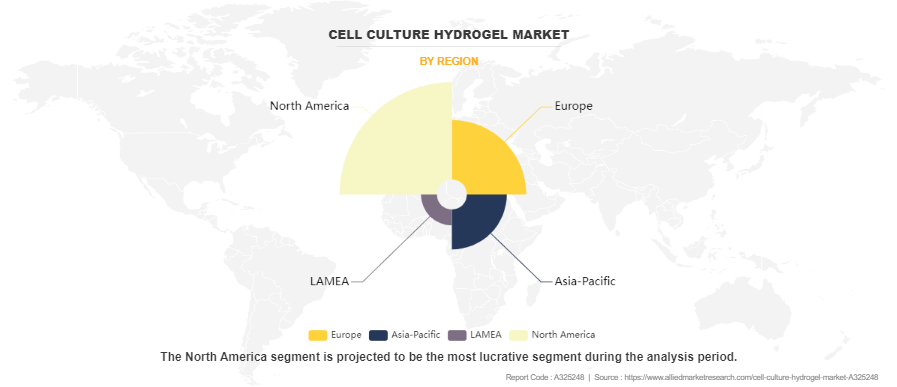
Competition Analysis
Key players such as Cell Guidance Systems and UPM have adopted collaboration and agreement as key developmental strategies to improve the product portfolio of the intraoral scanners market. For instance, in March 2021, UPM Biomedicals announced its collaboration with bio convergence company CELLINK. The partnership brings together UPM’s expertise for producing non-animal derived, nanocellulose biomaterials with CELLINK’s years of experience in method development for 3D bioprinting, offering new groundbreaking solutions to this growing life sciences market.
Recent Developments in Cell Culture Hydrogel Industry
- The life science group Sartorius and TheWell Bioscience agreed to partner on the development of hydrogels and bioinks tailored to produce 3D advanced cell models for drug discovery workflows. In addition to this, Sartorius will expand the portfolio of its lab division by distributing TheWell Bioscience’s products and invest in a minority shareholding in the company.
- In December 2023, UPM Biomedicals signed an extensive distribution agreement for GrowInk bioinks with Brinter Inc, a Finnish-US medtech/biotech company focusing on the development of cartilage implants using their patented 3D bioprinting technology.
- In July 2023, Merck announced the expansion of its facility in Lenexa, Kansas, USA adding 9,100 sq m2 of lab space and production capability to manufacture cell culture media.
- In February 2022, Humabiologics and Shanghai Besto Biotechnology Co., Ltd, a leader in distributing life science research supplies in China entered into a non-exclusive agreement to respond to the growing demand and serve a broader life sciences customer base of industry partners and academic institutions in the Chinese market.
- In April 2022, Cell Guidance Systems Ltd and Manchester BIOGEL, a biotechnology company specializing in the design and manufacture of 3D synthetic peptide hydrogels announced a collaboration to launch PODS-PeptiGels. The new kit combines the benefits of two existing innovative cell culture technologies - synthetic peptide hydrogels (PeptiGels) and a range of sustained release growth factors (PODS) - to provide a reproducible and highly adaptable environment for 3D cell culture
Key Benefits for Stakeholders
- This report provides a quantitative analysis of the market segments, current trends, estimations, and dynamics of the cell culture hydrogel market analysis from 2023 to 2035 to identify the prevailing cell culture hydrogel market opportunities.
- The market research is offered along with information related to key drivers, restraints, and opportunities.
- Porter's five forces analysis highlights the potency of buyers and suppliers to enable stakeholders make profit-oriented business decisions and strengthen their supplier-buyer network.
- In-depth analysis of the cell culture hydrogel market segmentation assists to determine the prevailing market opportunities.
- Major countries in each region are mapped according to their revenue contribution to the global market.
- Market player positioning facilitates benchmarking and provides a clear understanding of the present position of the market players.
- The report includes the analysis of the regional as well as global cell culture hydrogel market trends, key players, market segments, application areas, and market growth strategies.
Cell Culture Hydrogel Market Report Highlights
| Aspects | Details |
| Market Size By 2035 | USD 2.1 billion |
| Growth Rate | CAGR of 15% |
| Forecast period | 2023 - 2035 |
| Report Pages | 321 |
| By Type of Hydrogel |
|
| By Application |
|
| By End User |
|
| By Region |
|
| Key Market Players | BICO, PELOBIOTECH GmbH, UPM, Merck KGaA, Cell Guidance Systems, TheWell Bioscience Inc., Corning Incorporated, Humabiologics, Inc, CD Bioparticles, Cellendes GmbH |
The total market value of cell culture hydrogel market is $400 million in 2023
The market value of cell culture hydrogel market is estimated to reach $2,136.7 million by 2035.
The forecast period for cell culture hydrogel market is 2024-2035.
The base year is 2023 in cell culture hydrogel market
Key trends in the cell culture hydrogel market include a rise in demand for 3D cell culture models for drug discovery and tissue engineering, increasing adoption of hydrogel-based scaffolds in regenerative medicine, and advancements in hydrogel formulations for enhanced biocompatibility and cell growth.
Loading Table Of Content...
Loading Research Methodology...



